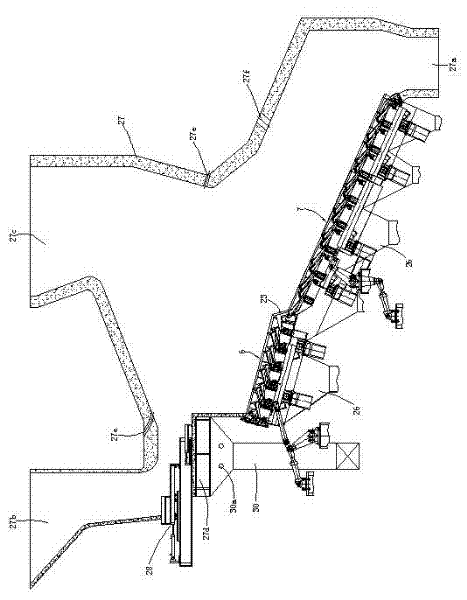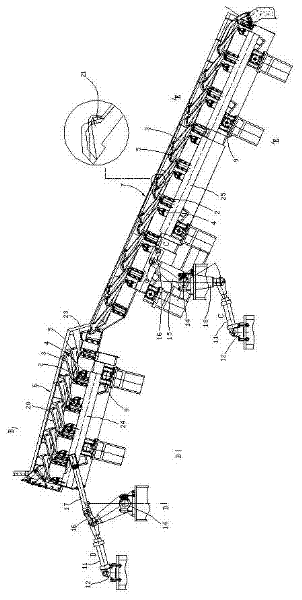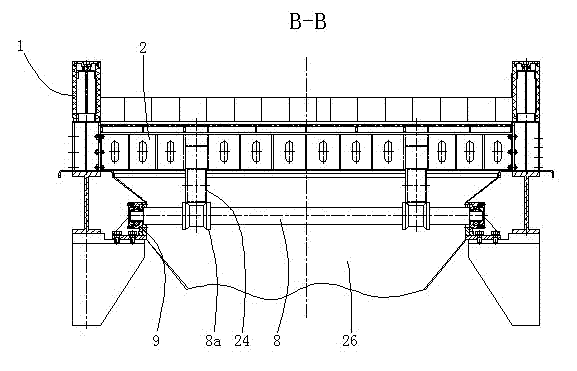The existing problems are as follows: First, for the characteristics of high water content and complex composition of domestic waste in our country, the reverse grate’s ability to transport this type of waste is weak, especially the bottom layer of waste in the drying stage, which is easy to form agglomerates or blocks, pasted on the grate surface to stop movement or move very slowly, as the moisture content gradually decreases during the drying process, the garbage will continue to be transported forward; second, the bottom layer of garbage will stick to the grate surface during the drying stage, blocking the grate The first air hole on the top affects the air supply effect and has a greater impact on the drying effect. It prolongs the drying time, delays the ignition of the garbage, increases the residence time of the garbage in the entire furnace, and directly affects the incineration process in the furnace; During the drying stage, the upper layer of garbage is squeezed and conveyed forward, while the lower layer of garbage is conveyed relatively slowly, resulting in a large difference in the movement speed of the upper layer and the bottom layer of garbage.
The existing problems are as follows: First, in order to ensure the residence time of the garbage in the furnace, the design of the grate area is relatively large, or the design of the grate stroke is relatively large, which increases the height or length of the incinerator and increases the cost; The movement direction of the garbage material layer is the same. When the garbage material layer is high, the relative drop of adjacent grates is low or the relative stroke is small, the running garbage is almost in a relatively static state, the effect of stirring and mixing is poor, and the garbage is not fully dried. , cannot be fully burned, the combustion efficiency is low, and it is difficult to reach the index of ash slag thermal ignition loss rate
The existing problems are as follows: First, for the characteristics of high water content and complex composition of domestic waste in our country, the reverse push grate has a weak conveying capacity for this type of waste, especially in the garbage drying stage, and there is a problem of full reverse push grate Problem; second, in the forward-push combustion stage, the garbage is basically burned into ash, most of which are small-sized ash, and as the combustion stage proceeds, the ash content increases until it reaches ash. The index of slag thermal ignition loss rate, that is, the ash and slag transported by the horizontal push grate movement is very small, and it is easy to enter the lower primary air chamber through the grate gap or the primary air hole, resulting in a large amount of ash output from this air chamber. It is not conducive to the centralized collection and treatment of ash; third, dust enters the movement mechanism part of the primary air chamber, causing greater wear and tear on the movement pair, affecting the normal operation of the mechanism, and forming ash collection on the fixed plate or fixed beam, affecting the primary air flow. Penetrate the material layer and enter the furnace to assist in the combustion and embers of waste
[0007] 1. For the characteristics of high water content and complex composition of domestic waste in our country, reverse the conveying capacity of the grate to the waste, especially in the dry stage, the waste material layer is easy to form lumps or blocks, which are pasted on the grate surface, affecting drying Conveyance of process and waste;
[0008] 2. During the reverse grate drying stage, the bottom layer of garbage will stick to the grate surface, block the primary air hole on the grate, prolong the drying time, increase the residence time of the garbage in the entire furnace, and directly affect the incineration process in the furnace;
[0009] 3. Due to the continuous feeding of the pusher into the furnace, the upper layer of garbage is squeezed forward during the drying stage, and the lower layer of garbage is transported relatively slowly, resulting in a large difference in the movement speed of the upper layer and the lower layer of garbage;
[0010] 4. In order to ensure the residence time of the garbage in the furnace, the area of the grate is designed to be larger, or the stroke of the grate is designed to be larger, which increases the height or length of the incinerator and increases the cost;
[0011] 5. The forward grate moves in the same direction as the garbage material layer. When the garbage material layer is high, the relative drop between adjacent grates is low or the relative stroke is small, the running garbage is almost in a relatively static state, stirring and mixing The effect is poor, the garbage is not dried enough, can not be fully burned, the combustion efficiency is low, and it is difficult to reach the index of the thermal ignition reduction rate of ash;
[0012] 6. The leachate in the garbage layer will be pushed forward by the push grate before it evaporates, which will increase the drying time of the garbage. If the leachate is not collected in time, the residence time of the garbage in the entire furnace will be increased, and all of it will be in the furnace Evaporate into water vapor, increase the moisture content in the flue gas, and affect the incineration process;
[0014] 8. The periodic intermittent control method makes the grate stop for a part of the time. If the time is too long, the lower position of the material layer is easy to burn the grate, and the higher position of the material layer is not dry enough, it is difficult to burn, and the stop time is too long. If it is short, the residence time in the furnace cannot be guaranteed, and the combustion efficiency is low, which will make it difficult to reach the index of thermal ignition reduction rate of ash and slag
[0015] 9. If the waste incineration grate has too many segments, the complexity of the mechanism will be increased, the high failure rate will be higher, and the cost will be higher, which puts higher requirements on the algorithm of the control system;
[0016] 10. In the forward combustion stage, the garbage is basically burned into ash, most of which are small-sized ash, and as the combustion stage progresses, the ash content increases until it reaches the ash hot burning stage. The indicator of the reduction rate, that is, the ash and slag transported by the horizontal push grate movement is very small in size, and it is easy to enter the primary air chamber below through the grate gap or the primary air hole, resulting in a large amount of ash output from this air chamber, which is not conducive to ash Centralized collection and treatment of slag;
[0017] Dust enters the moving mechanism part of the primary air chamber, causing greater wear and tear on the moving pair, affecting the normal operation of the mechanism, and forming dust collection on the fixed plate or fixed beam, affecting the penetration of the primary air through the material layer, entering the furnace, and assisting garbage burn, embers
 Login to View More
Login to View More  Login to View More
Login to View More 


